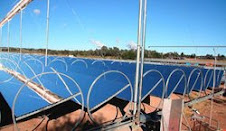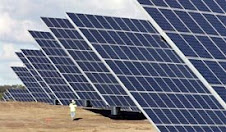Radiation releases many times greater than reported
Here are some excerpts I've just read about Fukushima's nuclear meltdown / melt-through disaster:
The exposed reactors and fuel cores are continuing to release microns of caesium, strontium, and plutonium isotopes. These are referred to as "hot particles".
"We are discovering hot particles everywhere in Japan, even in Tokyo," he said. "Scientists are finding these everywhere. Over the last 90 days these hot particles have continued to fall and are being deposited in high concentrations. A lot of people are picking these up in car engine air filters."
Radioactive air filters from cars in Fukushima prefecture and Tokyo are now common, and Gundersen says his sources are finding radioactive air filters in the greater Seattle area of the US as well.
The hot particles on them can eventually lead to cancer.
"These get stuck in your lungs or GI tract, and they are a constant irritant," Arnold Gundersen, a former nuclear industry senior vice president, explained, "One cigarette doesn't get you, but over time they do. These [hot particles] can cause cancer, but you can't measure them with a Geiger counter. Clearly people in Fukushima prefecture have breathed in a large amount of these particles. Clearly the upper West Coast of the US has people being affected. That area got hit pretty heavy in April."
"Largest industrial catastrophe in history" claims nuclear scientist
"Fukushima is the biggest industrial catastrophe in the history of mankind," Arnold Gundersen told Al Jazeera.
Japan's 9.0 earthquake on March 11 caused a massive tsunami that crippled the cooling systems at the Tokyo Electric Power Company's (TEPCO) nuclear plant in Fukushima, Japan. It also led to hydrogen explosions and reactor meltdowns that forced evacuations of those living within a 20km radius of the plant.
Gundersen, a licensed reactor operator with 39 years of nuclear power engineering experience, managing and coordinating projects at 70 nuclear power plants around the US, says the Fukushima nuclear plant likely has more exposed reactor cores than commonly believed.
"Fukushima has three nuclear reactors exposed and four fuel cores exposed," he said, "You probably have the equivalent of 20 nuclear reactor cores because of the fuel cores, and they are all in desperate need of being cooled, and there is no means to cool them effectively."
TEPCO has been spraying water on several of the reactors and fuel cores, but this has led to even greater problems, such as radiation being emitted into the air in steam and evaporated sea water - as well as generating hundreds of thousands of tons of highly radioactive sea water that has to be disposed of.
"The problem is how to keep it cool," says Gundersen. "They are pouring in water and the question is what are they going to do with the waste that comes out of that system, because it is going to contain plutonium and uranium. Where do you put the water?"
Even though the plant is now shut down, fission products such as uranium continue to generate heat, and therefore require cooling.
"The fuels are now a molten blob at the bottom of the reactor," Gundersen added. "TEPCO announced they had a melt through. A melt down is when the fuel collapses to the bottom of the reactor, and a melt through means it has melted through some layers. That blob is incredibly radioactive, and now you have water on top of it. The water picks up enormous amounts of radiation, so you add more water and you are generating hundreds of thousands of tons of highly radioactive water."
Independent scientists have been monitoring the locations of radioactive "hot spots" around Japan, and their findings are disconcerting.
"We have 20 nuclear cores exposed, the fuel pools have several cores each, that is 20 times the potential to be released than Chernobyl," said Gundersen. "The data I'm seeing shows that we are finding hot spots further away than we had from Chernobyl, and the amount of radiation in many of them was the amount that caused areas to be declared no-man's-land for Chernobyl. We are seeing square kilometres being found 60 to 70 kilometres away from the reactor. You can't clean all this up. We still have radioactive wild boar in Germany, 30 years after Chernobyl."
Radiation may be affecting newborns in USA Northwest
Japan's Nuclear Emergency Response Headquarters finally admitted earlier this month that reactors 1, 2, and 3 at the Fukushima plant experienced full meltdowns.
TEPCO announced that the accident probably released more radioactive material into the environment than Chernobyl, making it the worst nuclear accident on record.
Meanwhile, a nuclear waste advisor to the Japanese government reported that about 966 square kilometres near the power station - an area roughly 17 times the size of Manhattan - is now likely uninhabitable.
In the US, physician Janette Sherman MD and epidemiologist Joseph Mangano published an essay shedding light on a 35 per cent spike in infant mortality in northwest cities that occurred after the Fukushima meltdown, and may well be the result of fallout from the stricken nuclear plant.
The eight cities included in the report are San Jose, Berkeley, San Francisco, Sacramento, Santa Cruz, Portland, Seattle, and Boise, and the time frame of the report included the ten weeks immediately following the disaster.
"There is and should be concern about younger people being exposed, and the Japanese government will be giving out radiation monitors to children," Dr MV Ramana, a physicist with the Programme on Science and Global Security at Princeton University who specialises in issues of nuclear safety, told Al Jazeera.
Dr Ramana explained that he believes the primary radiation threat continues to be mostly for residents living within 50km of the plant, but added: "There are going to be areas outside of the Japanese government's 20km mandatory evacuation zone where radiation is higher. So that could mean evacuation zones in those areas as well."








No comments:
Post a Comment